|
|
THE DORE GALLERY OF
BIBLE ILLUSTRATIONS
By
Gustave Dore
Volume 8.
With a click all images will expand to their full size
JESUS AND THE WOMAN TAKEN IN ADULTERY.
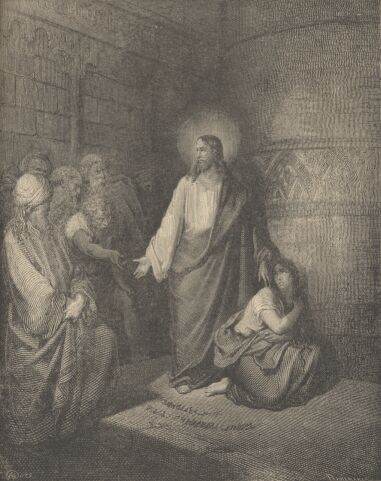
Jesus went unto the mount of Olives. And early in the morning
he came again into the temple, and all the people came unto him;
and he sat down, and taught them.
And the scribes and Pharisees brought unto him a woman taken
in adultery; and when they had set her in the midst, they say
unto him, Master, this woman was taken in adultery, in the very
act. Now Moses in the law commanded us, that such should be
stoned: but what sayest thou? This they said, tempting him, that
they might have to accuse him.
But Jesus stooped down, and with his finger wrote on the
ground, as though he heard them not.
So when they continued asking him, he lifted up himself, and
said unto them, He that is without sin among you, let him first
cast a stone at her.
And again he stooped down, and wrote on the ground.
And they which heard it, being convicted by their own
conscience, went out one by one, beginning at the eldest, even
unto the last; and Jesus was left alone, and the woman standing
in the midst. When Jesus had lifted up himself, and saw none but
the woman, he said unto her, Woman where are those thine
accusers? Hath no man condemned thee? She said, No man, Lord.
And Jesus said unto her, Neither do I condemn thee: go, and
sin no more. —john viii, 1-11
THE RESURRECTION OF LAZARUS.
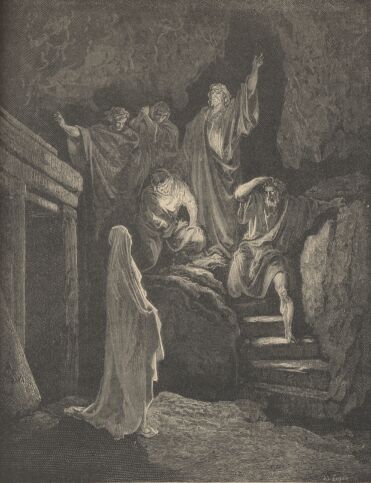
Now Jesus was not yet come into the town, but was in that
place where Martha met him. The Jews then which were with her in
the house, and comforted her, when they saw Mary, that she rose
up hastily and went out, followed her, saying, She goeth unto the
grave to weep there. Then when Mary was come where Jesus was, and
saw him, she fell down at his feet, saying unto him, Lord, if
thou hadst been here, my brother had not died.
When Jesus therefore saw her weeping, and the Jews also
weeping which came with her, he groaned in the spirit, and was
troubled, and said, Where have ye laid him?
They said unto him, Lord, come and see.
Jesus wept.
Then said the Jews, Behold how he loved him! And some of them
said, Could not this man, which opened the eyes of the blind,
have caused that even this man should not have died?
Jesus therefore again groaning in himself cometh to the grave.
It was a cave and a stone lay upon it. Jesus said, Take ye away
the stone.
Martha, the sister of him that was dead, saith unto him, Lord,
by this time he stinketh for he hath been dead four days.
Jesus saith unto her, Said I not unto thee, that, if thou
wouldest believe, thou shouldest see the glory of God?
Then they took away the stone from the place where the dead
was laid.
And Jesus lifted up his eyes, and said, Father, I thank thee
that thou hast heard me. And I knew that thou hearest me always:
but because of the people which stand by I said it, that they may
believe that thou hast sent me.
And when he thus had spoken, he cried with a loud voice,
Lazarus, come forth.
And he that was dead came forth, bound hand and foot with
graveclothes: and his face was bound about with a napkin.
Jesus saith unto them, Loose him, and let him go.
Then many of the Jews which came to Mary, and had seen the
things which Jesus did, believed on him.—John xi, 30-45
MARY MAGDALENE.
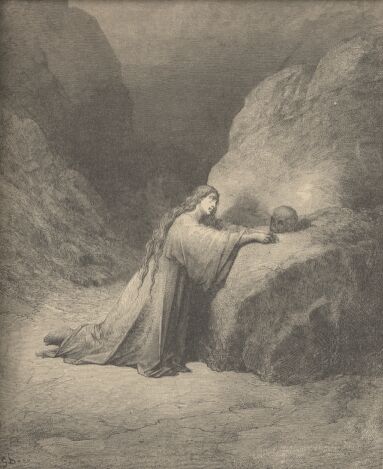
Of Mary "called Magdalene" (Luke viii, 2) but few particulars
are recorded in scripture. We first hear of her as having been
delivered by Jesus of seven devils (Luke viii, 1-3; Mark xvi, 9).
Impelled, no doubt, by gratitude for her deliverance, she becomes
one of his followers, accompanying him thenceforward in all his
wanderings faithfully till his death. She was the first person to
whom he appeared after his resurrection (Mark xvi, 9; John xx, 1,
11-18) The common belief that she was a fallen woman is destitute
of the slightest foundation. On the contrary, the references to
her as being in the company of such women as Joanna, the wife of
Herod's steward, Salome, the mother of James and John, and Mary,
the mother of Jesus (Luke viii, 3; Mark xvi, 40; John xix, 25),
strongly discountenance such a supposition. The error, which had
no other source than ecclesiastical tradition, has been fostered
and perpetuated by the stupid blunder of the translators of the
authorized version in identifying her with the "sinner" who is
described in Luke vii, 37-50 as washing the feet of Jesus with
her tears (see head-note to Luke vii).
The Roman Catholic notion that this "sinner" was Mary the
sister of Lazarus is almost equally groundless (see Douay Bible,
head-note to Matthew xxvi, and the foot-note references to Luke
vii, 37, found in most Catholic Bibles). The only reason for this
identification is that the anointing by the "sinner" is described
as taking place in the house of a Pharisee named Simon (Luke vii,
36, 39-40 43-44); that the anointing by the unnamed woman, as
described in Matthew xxvi, 6-13 and Mark xiv, 3-9, took place in
the house of one "Simon the leper," in Bethany; and that Mary,
the sister of Lazarus, is described in John xi, 2, and xii, 3-8,
as anointing Jesus in a house (apparently that of Lazarus
himself) in Bethany, when a conversation ensues altogether
different from that recorded in Luke vii, but similar to that
related in Matthew xxvi, and Mark xiv, save that the objection to
the anointing of Jesus is made, not by "his disciples" (Matthew
xxvi, 8), not by "some that had indignation" (Mark xiv, 4), but
by "one of his disciples, Judas Iscariot, Simon's son" (John xii,
4). The demeanor of Mary, the sister of Lazarus, is, however, by
no means that of a fallen and sinful though penitent woman but
that of a pious and good one (see Luke x, 39, 42; John xi, 28-33;
xii, 3).
Dore's illustration, which portrays Mary Magdalene as a
heartbroken and despairing sinner, shows that he has fallen into
the common error.
THE LAST SUPPER.
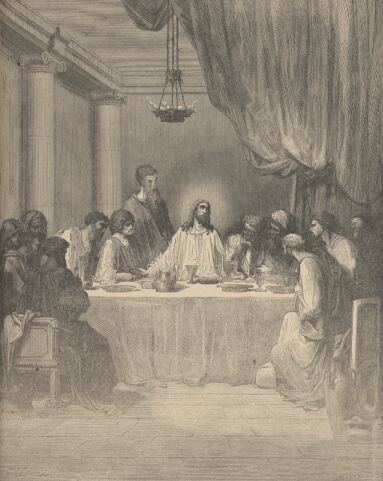
Now the first day of the feast of unleavened bread the
disciples came to Jesus, saying unto him, Where wilt thou that we
prepare for thee to eat the passover? And he said, Go into the
city to such a man, and say unto him, The Master saith, My time
is at hand; I will keep the passover at thy house with my
disciples. And the disciples did as Jesus had appointed them; and
they made ready the passover.
Now when the even was come, he sat down with the twelve. And
as they did eat, he said, Verily I say unto you, that one of you
shall betray me.
And they were exceeding sorrowful, and began every one of them
to say unto him, Lord, is it I?
And he answered and said, He that dippeth his hand with me in
the dish, the same shall betray me. The Son of man goeth as it is
written of him: but woe unto that man by whom the Son of man is
betrayed! it had been good for that man if he had not been born.
Then Judas, which betrayed him, answered and said, Master, is it
I? He said unto him, Thou hast said.
And as they were eating, Jesus took bread, and blessed it, and
brake it, and gave it to the disciples, and said, Take, eat; this
is my body. And he took the cup, and gave thanks, and gave it to
them, saying, Drink ye all of it; for this is my blood of the new
testament, which is shed for many for the remission of sins. But
I say unto you, I will not drink henceforth of this fruit of the
vine, until that day when I drink it new with you in my Father's
kingdom.
And when they had sung an hymn, they went out into the mount
of Olives.—Matthew xxvi, 17-30.
THE AGONY IN THE GARDEN.
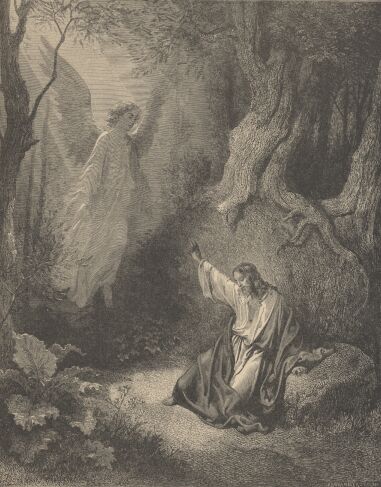
And he came out, and went, as he was wont, to the mount of
Olives; and his disciples all followed him. And when he was at
the place, he said unto them, Pray that ye enter not in
temptation.
And he was withdrawn from them about a stone's cast, and
kneeled down, and prayed Saying, Father, if thou be willing,
remove this cup from me: nevertheless not my will, but thine, be
done.
And there appeared an angel unto him from heaven,
strengthening him.
And being in an agony he prayed more earnestly: and his sweat
was as it were great drops, of blood falling down to the
ground.
And when he rose up from prayer, and was come to his
disciples, he found them sleeping for sorrow, and said unto them,
Why sleep ye? rise and pray, lest ye enter into temptation—Luke
xxii, 39-46.
PRAYER OF, JESUS IN THE GARDEN OF' OLIVES.
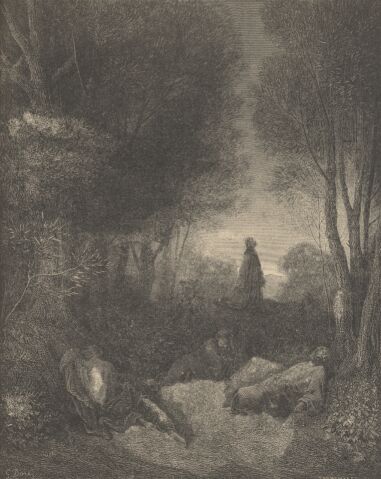
Then cometh Jesus with them unto a place called Gethsemane,
and saith unto, the disciples, Sit ye here, while I go and pray
yonder. And he took with him Peter and the two sons of Zebedee,
and began to be sorrowful and very heavy. Then saith he unto
them, My soul is exceeding sorrowful, even unto death: tarry ye
here, and watch with me.
And he went a little farther, and fell on his face, and
prayed, saying, O my Father, if be possible, let this cup pass
from me: nevertheless not as I will, but as thou wilt.
And he cometh unto the disciples, and findeth them asleep, and
saith unto Peter, What, could ye not watch with me one hour?
Watch and pray, that ye enter not into temptation the spirit
indeed is willing, but the flesh is weak.
He went away again the second time, and prayed, saying, O my
Father, if this cup may not pass away from me, except I drink it,
thy will be done.
And he came and found them asleep again: for their eyes were
heavy.
And he left them, and went away again, and prayed the third
time, saying the same words.
Then cometh he to his disciples, and saith unto them, Sleep on
now, and take your rest behold, the hour is at hand, and the Son
of man is betrayed into the hands of sinners. Rise let us be
going: behold, he is at hand that doth betray me. Matthew xxvi,
36-46
THE BETRAYAL.
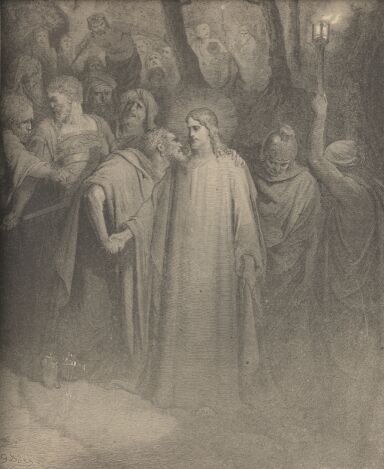
And he cometh the third time, and saith unto them, Sleep on
now, and take your rest it is enough, the hour is come; behold,
the Son of man is betrayed into the hands of sinners. Rise up,
let us go; lo, he that betrayeth me is at hand.
And immediately, while he yet spake, cometh Judas, one of the
twelve, and with him great multitude with swords and staves, from
the chief priests and the scribes and the elders. And he that
betrayed him had given them a token, saying, Whomsoever I shall
kiss, that same is he; take him, and lead him away safely. And as
soon as he was come, he goeth straight way to him, and saith,
Master, master; and kissed him.
And they laid their hands on him, and took him. And one of
them that stood by drew a sword, and smote a servant of the high
priest, and cut off his ear. And Jesus answered and said unto
them, Are ye come out, as against a thief, with swords and with
staves to take me? I was daily with you in the temple teaching,
and ye took me not but the scriptures must be fulfilled.
And they all forsook him, and fled.—Mark xiv, 41-50.
CHRIST FAINTING UNDER THE CROSS.
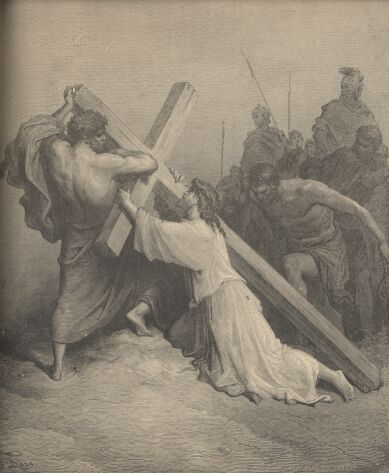
The incident depicted in this illustration seems to be as
apocryphal as that embodied in the artist's picture of Mary
Magdalene. There is absolutely no warrant in scripture for the
notion that Christ fainted under the burden of the cross. The
only foundation for such an idea to found in the Bible is
contained in the head note to Mark xv, which is quite unwarranted
by the text. According to the three synoptic gospels the cross
was borne not by Christ, but by Simon, a Cyrenian (see Matthew
xxvii, 32; Mark xv, 2 1; Luke xxiii, 26). According to the fourth
evangelist, Jesus bore the cross without assistance the whole
distance to the place crucifixion (John xix, 16-18). In not one
of the four narratives is there so much as a hint that he fainted
under the burden.
THE FLAGELLATION.
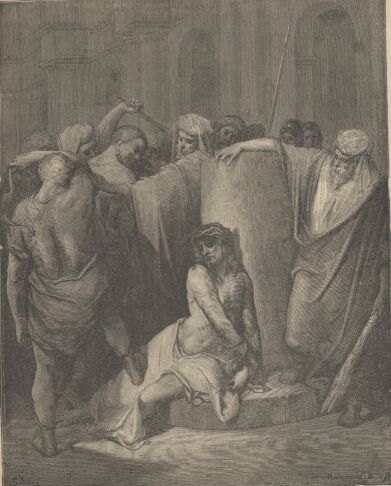
Then released he Barabbas unto them: and when he had scourged
Jesus, he deliver him to be crucified.—Matthew xxvii, 26.
And so Pilate, willing to content the people, released
Barabbas unto them, and deliver Jesus, when he had scourged him,
to be crucified.—Mark xv, 15.
Then Pilate therefore took Jesus, and scourged him. John
xix.
THE CRUCIFIXION.
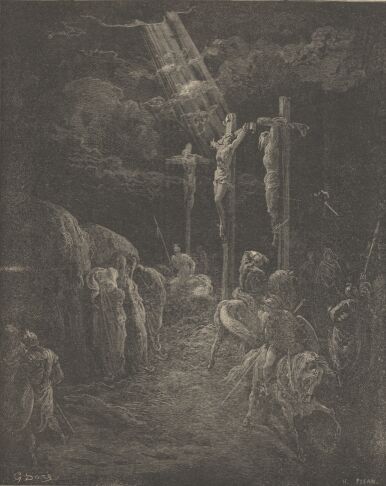
And when they were come unto a place called Golgotha, that is
to say, a place of a skull they gave him vinegar to drink mingled
with gall: and when he had tasted thereof, he would not drink.
And they crucified him, and parted his garments, casting lots:
that it might be fulfilled which was spoken by the prophet, They
parted my garments among them, and upon my vesture did they cast
lots. And sitting down they watched him there; and set up over
his head his accusation written, THIS IS JESUS THE KING OF THE
JEWS.
Then were there two thieves crucified with him, one on the
right hand, and another on the left.
And they that passed by reviled him, wagging their heads, and
saying, Thou that destroyest the temple, and buildest it in three
days, save thyself. If thou be the Son of God come down from the
cross.
Likewise also the chief priests mocking him, with the scribes
and elders, said, He saved others: himself he cannot save. If he
be the King of Israel, let him now come down from the cross, and
we will believe him. He trusted in God; let him deliver him now,
if he will have him: for he said, I am the Son of God.
The thieves also, which were crucified with him, cast the same
in his teeth.—Matthew xxvii, 33—44.
CLOSE OF THE CRUCIFIXION.
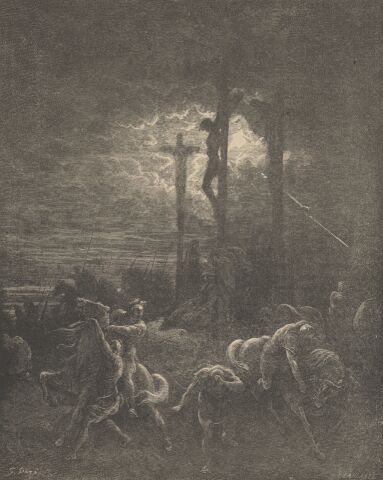
Now from the sixth hour there was darkness over all the land
unto the ninth hour. And about the ninth hour Jesus cried with a
loud voice, saying, Eli, Eli, lama sabachthani? that is to say,
My God, my God, why hast thou forsaken me?
Some of them that stood there, when they heard that, said,
This man calleth for Elias. And straightway one of them ran, and
took a sponge, and filled it with vinegar, and put it on a reed,
and gave him to drink. The rest said, Let be, let us see whether
Elias will come to save him.
Jesus, when he had cried again with a loud voice, yielded up
the ghost.
And, behold, the veil of the temple was rent in twain from the
top to the bottom; and the earth did quake, and the rocks rent;
and the graves were opened; and many bodies of the saints which
slept arose, and came out of the graves after his resurrection,
and went into the holy city, and appeared unto many.
Now when the centurion, and they that were with him, watching
Jesus, saw the earthquake, and those things that were done, they
feared greatly, saying, Truly this was the Son of God.
And many women were there beholding afar off, which followed
Jesus from Galilee, ministering unto him: among which was Mary
Magdalene, and Mary the mother of James and Joses, and the mother
of Zebedee's children.—Matthew xxvii, 45-56.
|











